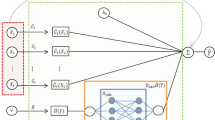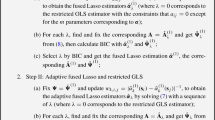Abstract
Deep learning technology has been successfully applied in more and more fields. In this paper, the application of deep neural networks in higher-order nonparametric spatial autoregressive models is studied. For spatial model, we propose the higher-order nonparametric spatial autoregressive neural network (HNSARNN) to fit the model. This method offers both good interpretability and prediction performance, and solves the black box problem in deep learning models to some degree. In various scenarios of spatial data distribution, the proposed method demonstrates superior performance compared to traditional approaches for handling nonparametric functions (such as the B-spline method). Simulation results show the effectiveness of the proposed model.




Similar content being viewed by others
Explore related subjects
Discover the latest articles, news and stories from top researchers in related subjects.Availability of data and materials
This study has associated data in data repositories.
References
Anselin L (1988) Spatial econometrics: Methods and models
Badinger H, Egger PH (2008) Horizontal vs. vertical interdependence in multinational activity. ERN: Theory & Evidence on Vertical & Horizontal Integration (Topic)
Badinger H, Egger PH (2013) Estimation and testing of higher-order spatial autoregressive panel data error component models. J Geogr Syst 15:453–489
Basile R (2008) Regional economic growth in europe: A semiparametric spatial dependence approach
Bauer B, Kohler M (2019) On deep learning as a remedy for the curse of dimensionality in nonparametric regression. The Annals of Statistics
Blommestein HJ (1985) Elimination of circular routes in spatial dynamic regression equations. Reg Sci Urban Econ 15:121–130
Cliff AD (1973) Spatial autocorrelation. Technical report
Du J, Sun X, Cao R, Zhang Z (2018) Statistical inference for partially linear additive spatial autoregressive models. Spatial Statistics
Elhorst JP, Lacombe DJ, Piras G (2012) On model specification and parameter space definitions in higher order spatial econometric models. Reg Sci Urban Econ 42:211–220
Lee L (2007) Gmm and 2sls estimation of mixed regressive, spatial autoregressive models. J Econometr 137:489–514
Lee L, Liu X (2009) Efficient gmm estimation of high order spatial autoregressive models with autoregressive disturbances. Economet Theor 26:187–230
Gupta A, Robinson PM (2015) Inference on higher-order spatial autoregressive models with increasingly many parameters. J Econometr 186:19–31
Han X, Hsieh CS, Lee LF (2017) Estimation and model selection of higher-order spatial autoregressive model: An efficient bayesian approach. Reg Sci Urban Econ 63:97–120
Hornik K, Stinchcombe MB, White HL (1989) Multilayer feedforward networks are universal approximators. Neural Netw 2:359–366
Hoshino T (2021) Sieve iv estimation of cross-sectional interaction models with nonparametric endogenous effect. J Econometr
Huang D, Anh VV (1992) Estimation of spatial arma models. Aust N Z J Stat 34:513–530
Kang X, Li T (2022) Estimation and testing of a higher-order partially linear spatial autoregressive model. J Stat Comput Simul 92:3167–3201
Kelejian HH, Prucha IR (1998) A generalized spatial two-stage least squares procedure for estimating a spatial autoregressive model with autoregressive disturbances. J Real Estate Fin Econ 17:99–121
Kirkwood C, Economou T, Pugeault N, Odbert HM (2022) Bayesian deep learning for spatial interpolation in the presence of auxiliary information. Math Geosci 54:507–531
Kurisu D, Fukami R, Koike Y (2022) Adaptive deep learning for nonlinear time series models
LeCun Y, Bottou L, Bengio Y, Haffner P (1998) Gradient-based learning applied to document recognition. Proc IEEE 86:2278–2324
LeSage JP, Pace RK (2011) Pitfalls in higher order model extensions of basic spatial regression methodology. Rev Reg Stud 41:13–26
Leshno M, Lin VY, Pinkus A, Schocken S (1991) Multilayer feedforward networks with a nonpolynomial activation function can approximate any function. New York University Stern School of Business Research Paper Series
Li K, Zhu J, Ives AR, Radeloff VC, Wang F (2023) Semiparametric regression for spatial data via deep learning. Spatial Stat 57:100777
Martelli M (1999) Introduction to discrete dynamical systems and chaos
Medeiros MC, Teräsvirta T, Rech G (2002) Building neural network models for time series: A statistical approach
Ord K (1975) Estimation methods for models of spatial interaction. J Am Stat Assoc 70:120–126
Ramachandran P, Zoph B, Le QV (2018) Searching for activation functions. arXiv:1710.05941
Schmidhuber J (2014) Deep learning in neural networks: An overview. Neural Netw 61:85–117
Schmidt-Hieber J (2020) Nonparametric regression using deep neural networks with ReLU activation function. Ann Stat 48(4):1875–1897
Su L, Jin S (2010) Profile quasi-maximum likelihood estimation of partially linear spatial autoregressive models. J Econometr 157:18–33
Tao J (2005) Spatial econometrics: models, methods and applications
Wang W, Andrews B (2018) Partially specified spatial autoregressive model with artificial neural network
Wang Z, Song Y (2023) Deep learning for the spatial additive autoregressive model with nonparametric endogenous effect. Spatial Statistics
Yarotsky D (2016) Error bounds for approximations with deep relu networks. Neural Netw 94:103–114
Zhong Q, Mueller JW, Ling Wang J (2022) Deep learning for the partially linear cox model. The Annals of Statistics
Acknowledgements
The researches are supported by the National Key Research and Development Program of China (2021YFA1000102).
Funding
This study was supported by the National Key Research and Development Program of China (2021YFA1000102).
Author information
Authors and Affiliations
Contributions
Prof. Yunquan Song: study conception and design, development of methodology; Zitong Li: data analysis, interpretation, and manuscript preparation and editing; Ling Jian: study conception and design.
Corresponding author
Ethics declarations
Conflicts of interest
The authors declare no conflict of interest.
Additional information
Publisher's Note
Springer Nature remains neutral with regard to jurisdictional claims in published maps and institutional affiliations.
Rights and permissions
Springer Nature or its licensor (e.g. a society or other partner) holds exclusive rights to this article under a publishing agreement with the author(s) or other rightsholder(s); author self-archiving of the accepted manuscript version of this article is solely governed by the terms of such publishing agreement and applicable law.
About this article
Cite this article
Li, Z., Song, Y. & Jian, L. Deep learning for higher-order nonparametric spatial autoregressive model. Appl Intell 54, 7570–7580 (2024). https://doi.org/10.1007/s10489-024-05541-8
Accepted:
Published:
Issue Date:
DOI: https://doi.org/10.1007/s10489-024-05541-8




